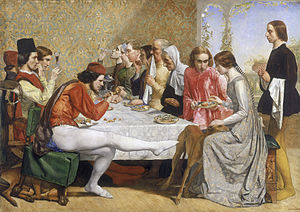Isabella (Millais painting)
| Isabella | |
|---|---|
 |
|
| Artist | John Everett Millais |
| Year | 1849 |
| Medium | Oil on canvas |
| Dimensions | 103 cm × 142.8 cm (41 in × 56.2 in) |
| Location | Walker Art Gallery, Liverpool |
 |
|
|
|
Isabella (1849), also known as Lorenzo and Isabella, is a painting by John Everett Millais, which was his first work in the Pre-Raphaelite style, created shortly after the formation of the Pre-Raphaelite Brotherhood in the previous year. It was first exhibited at the Royal Academy in 1849, and is now in the collection of the Walker Art Gallery in Liverpool.
The painting illustrates an episode from Giovanni Boccaccio's Decameron novel Lisabetta e il testo di bassilico (1349 - 1353), reprised by John Keats's poem, Isabella, or the Pot of Basil, which describes the relationship between Isabella, the sister of wealthy medieval merchants, and Lorenzo, an employee of Isabella's brothers. It depicts the moment at which Isabella's brothers realise that there is a romance between the two young people, and plot to murder Lorenzo so they can marry Isabella to a wealthy nobleman. Isabella, wearing grey at the right, is being handed a blood orange on a plate by the doomed Lorenzo. A cut blood orange is symbolic of the neck of someone who has just been decapitated, referring to Isabella cutting off Lorenzo's head to take it with her after finding him buried. One of her brothers violently kicks a frightened dog while cracking a nut.
Millais and his colleague William Holman Hunt had both produced drawings illustrating episodes from the poem, but only Millais worked his up into a full painting (Hunt's 1868 Isabella and the Pot of Basil used a completely different composition). Both drawings used distorted perspective and angular poses characteristic of medieval art, by which the Pre-Raphaelites were influenced. Millais also draws on the precedent of William Hogarth's satirical depictions of an arranged marriage Marriage à-la-mode.
The painting is structured with deliberately distorted perspective, elongating the right hand side of the table and flattening the figures ranged along it. Following Pre-Raphaelite theory, Millais almost eliminates chiaroscuro and exaggerates the intensity of juxtaposed colours and tones - as evidenced in the flat black tunic set against the sharply modelled white cloth of the servant at the right, whose lower body virtually disappears as his yellow stockings semi-merge with the background.
...
Wikipedia
